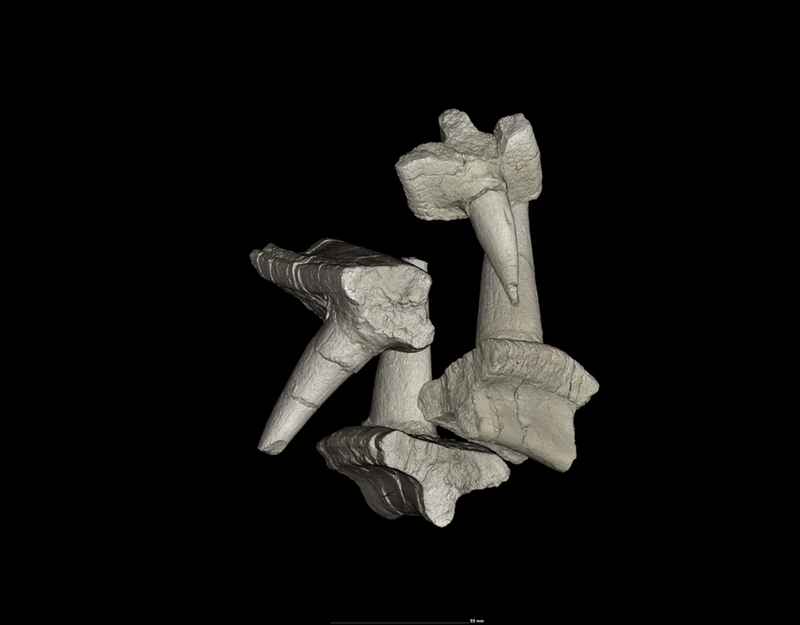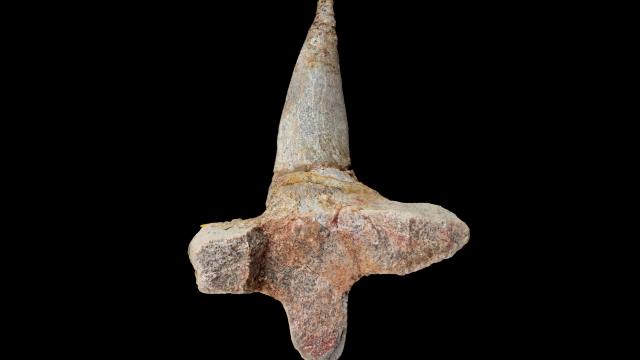A team of paleontologists announced this week the discovery of the oldest-known ankylosaur, a swaggering dinosaur famous for its armour plating and clubbed tail. But besides its superlative age of over 160 million years, the ankylosaur also had a bizarre morphology, as spines protruding from the animal’s back were fused to its ribs.
Ankylosaurs were built for defence. Their thick skulls and body armour bring to mind a tank, and paleontologists recently suggested the animals may have even burrowed into the ground to protect themselves. But the newly named species, Spicomellus afer, stands out among these sturdy creatures, as the researchers describe in their new paper, published yesterday in Nature Ecology & Evolution.
“All ankylosaurs had spikes on their backs, but in our specimen they are fused to the ribs. This is a morphology not seen in any other ankylosaur, and indeed in any other vertebrate, living or extinct,” Susannah Maidment, a paleontologist at the Natural History Museum in London, told Gizmodo in an email. The research was co-authored by scientists at the University of Fez in Morocco and the University of Zürich in Switzerland.
“The armour of ankylosaurs was most probably a defensive mechanism,” said Maidment, who is lead author of the recent paper. “It would have certainly been off-putting for predators to bite down on an animal covered in sharp spines like these!”

The entire fossil consists of a series of spikes, acquired by the National History Museum from a fossil dealer in 2018. The smallest spike is a little over 2 inches tall and the tallest is nearly 4 inches tall, though it’s missing its tip. If you were a meat-eating theropod, it likely wouldn’t be your first choice for a meal.
The research team wasn’t sure at first what sort of dinosaur the fossil fragments belonged to. The fossil came out of the Middle Atlas mountain range of Morocco, where stegosauruses once roamed, so that was a possibility. It wasn’t until the team scrutinised the bone under a microscope and saw the unique structure of the osteoderms (the plate-like armour that protected the animals) that they realised they were looking at an ankylosaur, the first to ever be found in Africa. That also gives the species its name: Spicomellus — “collar of spikes” — afer — “of Africa.”
“This is a really weird-looking specimen, but ankylosaur osteoderms come in some pretty surprising shapes and sizes. Several species from Europe, like Hungarosaurus, have cone-shaped spikes like this,” Victoria Arbour, a paleontologist at the Royal British Columbia Museum in Canada who specialises in ankylosaurs, told Gizmodo in an email.
“It’s really great to have another potential Middle Jurassic ankylosaur, since the fossil record of ankylosaurs from this time period is so scant, and I think this adds some interesting new evidence against the idea that stegosaurs were outcompeted by ankylosaurs at the end of the Jurassic,” added Arbour, who was not involved in the recent study.
Evidence of ankylosaurs is plentiful in the Cretaceous period, but S. afer dating from the Jurassic offers a tantalising glimpse into the animals’ more ancient roots. Maidment said that the research team hopes to return to the same rock that this fossil came from to see if more ankylosaurs from the time period can be found.
If so, it would help paleontologists understand if S. afer’s spike construction was the rule or the exception — whether it was a model for more ancient ankylosaurs or an aberrant member of the armour-plated dinosaur family tree.
More: Armoured Dinos May Have Dug Trenches to Protect Themselves, Study Suggests
